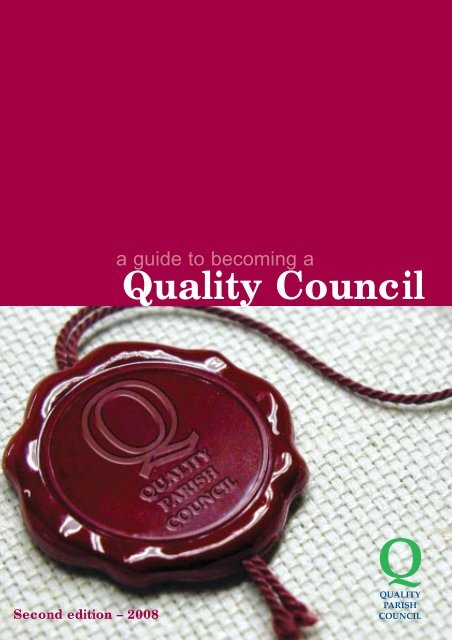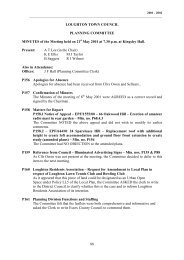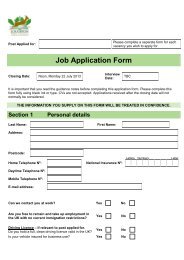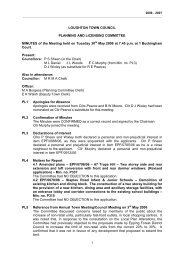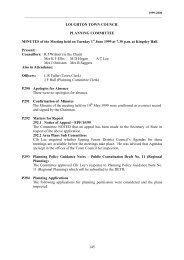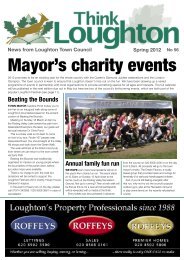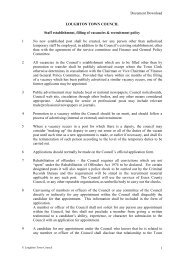Download - National Association of Local Councils
Download - National Association of Local Councils
Download - National Association of Local Councils
- No tags were found...
You also want an ePaper? Increase the reach of your titles
YUMPU automatically turns print PDFs into web optimized ePapers that Google loves.
Second edition – 2008a guide to becoming aQuality Council
ForewordGuide to becoming a Quality Council –Foreward by Councillor Ken Cleary, Chairman,NALC and Sam Shippen, Chairman, SLCCThe Quality Parish and Town Council Scheme has steadily grown since it waslaunched in March 2003. Quality status has been achieved by a diverse range<strong>of</strong> different councils ranging from those with electorates <strong>of</strong> tens <strong>of</strong> thousandsand annual budgets <strong>of</strong> as much as £1million to councils with electorates <strong>of</strong>less than 500 and annual budgets <strong>of</strong> just a few thousand pounds. What theyall have in common is a commitment to their local communities and byacquiring Quality status they have demonstrated to local people that they arerepresentative, in touch with their communities, competent, and capable <strong>of</strong>taking on an enhanced role.The Department for the Environment, Food and Rural Affairs commissionedthe University <strong>of</strong> Wales to review the Scheme in 2006 and their researchreport helped the <strong>National</strong> Stakeholders to agree amendments to the Schemethat, while not placing an undue burden on councils wishing to achieveQuality status, would ensure that the tests remained relevant to our tier,would help councils to achieve ever higher levels <strong>of</strong> pr<strong>of</strong>essionalism and helpcouncils to cement their position as community leaders.This, the second edition <strong>of</strong> the Quality Parish and Town Council Schemeguidance explains the steps that are required to achieve Quality status. It alsohighlights some <strong>of</strong> the benefits that Quality status <strong>of</strong>fers the council and theirwider community.All six <strong>National</strong> Stakeholders remain committed to the Scheme and thedevelopment <strong>of</strong> the tier in general. We see the Quality Parish and TownCouncil Scheme as an excellent way to increase the pr<strong>of</strong>ile <strong>of</strong> the tier. Thisrising pr<strong>of</strong>ile will continue to improve the reputation and perception <strong>of</strong> parishand town councils and place us in an ever strengthening position to assumea more important role in delivering improvements for our local communities.SignedKen Cleary, Chairman, NALCSam Shippen, Chairman, SLCC
2Chapter 1An Introduction toQuality StatusThis is a short guide to help your councilunderstand the benefits <strong>of</strong> gaining Qualitystatus and help them achieve it. The RuralWhite Paper, published in 2000, confirmed theGovernment’s support for parish and towncouncils and underlined their important roleas the first tier <strong>of</strong> government closest to localpeople, in giving local leadership and being atthe heart <strong>of</strong> local communities. Consequently,the Quality Parish and Town Council Schemewas launched in 2003 with the aim <strong>of</strong>providing a benchmark minimum standard forparish and town councils across the country.A review <strong>of</strong> the Scheme by the University <strong>of</strong>Wales in 2006 and the governments ongoinglocalism agenda prompted the <strong>National</strong>
Stakeholders to evaluate the Scheme and seewhether improvements could be made to ensurethat it remained relevant to the parish and towncouncil tier. A number <strong>of</strong> amendments to theScheme were agreed and this amended secondedition <strong>of</strong> the guidance provides a step-by-stepguide to the tests you will be required to meet.The Quality scheme is open to all parish and town councils inEngland, irrespective <strong>of</strong> size. It aims to enable parish councilsto work more closely with others in the delivery <strong>of</strong> localservices and to better represent their local communities.Whatever the circumstances, Quality status brings realbenefits, not only for the Quality council, but also for the peoplewho work with it and, more importantly, the community itserves. This guide goes through the scheme on a step-by-stepbasis, providing useful advice, information and case studies. Itshould prove a valuable tool for your council.“Quality status should be high on the list <strong>of</strong> prioritiesfor local councils, as the accreditation demonstratestheir ability to deliver efficient services to local residents andspeak with greater authority to principal councils whenseeking delegated functions which can be better carried outlocally. There is no bar for any local council to work towardsobtaining this award.”David Dubut, Clerk to Nettleham Parish CouncilIf you have any further questions about the scheme, theaccreditation process, or any <strong>of</strong> the topics covered in thisguide, please contact your County <strong>Association</strong> <strong>of</strong> <strong>Local</strong><strong>Councils</strong>, which should be able to help. A list <strong>of</strong> contact detailscan be found in the back <strong>of</strong> the document.3
AcknowledgmentsThe amended second edition <strong>of</strong> the guide was developed bythe <strong>National</strong> <strong>Association</strong> <strong>of</strong> <strong>Local</strong> <strong>Councils</strong> with advice from theother <strong>National</strong> Stakeholders, the Commission for RuralCommunities (CRC), the Department for Environment, Foodand Rural Affairs (DEFRA), the Department for Communitiesand <strong>Local</strong> Government (DCLG) and the <strong>Local</strong> Government<strong>Association</strong> (LGA) and the Society <strong>of</strong> <strong>Local</strong> Council Clerks(SLCC). Amendments to the Scheme were largely based onthe 2006 University <strong>of</strong> Wales research report ‘Research Study<strong>of</strong> the Quality Parish and Town Council Scheme’, which drewon the experiences from the tier and was commissioned byDEFRA. Feedback on the changes was drawn from across theparish and town council tier and the <strong>National</strong> Stakeholderswould specifically like to thank the clerks, councillors andcouncils that contributed to the revised Scheme.4
Chapter 2BackgroundThe Rural White Paper - ‘Our Countryside,The Future, A Fair Deal for Rural England’(published in 2000) - indicated that theGovernment wanted parish and town councilsto give local leadership at the heart <strong>of</strong> localgovernance. In other words the Government sawan important role for parish and town councils inrepresenting local people and improving both thequality and range <strong>of</strong> local services.The Government’s support has continued with itslocalism agenda and the <strong>Local</strong> Government &Public Involvement in Health Act which continueto show that the Government wants local councilsto show to their residents that they are capable <strong>of</strong>operating in an ethical way and that they are ableto represent their interests effectively.5
In June 2003, following an extensive period <strong>of</strong> consultation,the Office <strong>of</strong> the Deputy Prime Minister (ODPM) published ‘TheQuality Parish and Town Council Scheme; The Quality SchemeExplained’. The first edition <strong>of</strong> this guidance was published inOctober 2004. Both <strong>of</strong> these documents have beensuperseded by this booklet.All parish and town councils, <strong>of</strong> whatever size and whether ruralor urban, are encouraged and able to work towards achievingQuality status. This is illustrated by the broad range <strong>of</strong> sizes <strong>of</strong>some <strong>of</strong> the current Quality councils, ranging from the 280electors in Pertenhall & Swineshead Parish Council inBedfordshire to some 72,000 in Weston-super-Mare TownCouncil in Avon.Quality Parish or Town <strong>Councils</strong> are expected to:• be representative <strong>of</strong> and actively involve all parts <strong>of</strong>their community• be effectively and properly managed, with membersand <strong>of</strong>ficers upholding a high standard <strong>of</strong> conduct• work closely with voluntary and community sector groups,and articulate the community’s needs and wishes througheffective communications, which might include the production<strong>of</strong> parish plans or other similar documentsand• work in partnership with other local authorities and agenciesand, depending on their size, be able to deliver local serviceswhich give the best deal for the local community6
Chapter 3The Benefits <strong>of</strong>Quality StatusIn addition to being able to demonstrate to localcommunities that minimum standards have beenmet, Quality councils will also be in a betterposition to influence the decision making processand/or take on additional services and areas <strong>of</strong>responsibility from their principal local authorities.Who benefits?The benefits <strong>of</strong> this scheme affect three groups:1. the community2. the parish or town council itself3. the principal local authority7
1) The community:• more responsive services - the Quality council will becapable <strong>of</strong> solving local problems without recourse to theprincipal authority• real contact and discussions with its Quality council• a local access point providing information on services• a council which is more accountable, visible, representativeand provides community leadership2) Benefits to the parish or town council itself:• greater credibility in the eyes <strong>of</strong> the local community,voluntary and private sectors, and principal local authorities• greater civic pride• more representative <strong>of</strong> the local community• better ability to articulate the needs and wishes <strong>of</strong> thelocal community• more will be achieved by working in partnership withother organisations• ability to demonstrate that it is effectively andproperly managed, which will instill greater confidencein the community• can deliver more local services - if the council wishes to• greater involvement by the voluntary and community sectorand by principal local authorities (e.g. developing communityled plans, market town health checks etc.)• a better informed community• a well trained clerk, through the Certificate in <strong>Local</strong> CouncilAdministration (or University <strong>of</strong> Gloucestershire qualificationin <strong>Local</strong> Policy)8
3) Principal Authority benefits• reassurance that the Quality council has been independentlyassessed and is therefore capable <strong>of</strong> working together withthe principal authority to deliver services on their behalf orin partnership• reliable evidence <strong>of</strong> the competence <strong>of</strong> the Quality council,through the four year re-assessment process• pro<strong>of</strong> that the Quality council is willing and able to be fullyinvolved in local issues (this will be particularly valuable whenimplementing new initiatives)• stronger partnership working, with the town or parish councilbringing their local perspective and experience to the table.Quality councils should be more innovative and pro-active,and will want to share their ideas and experiences• increased confidence that the Quality council isrepresentative, competent, well managed, and thuscapable <strong>of</strong> taking on and sustaining an enhanced role“In achieving Quality status, we have demonstratedto our principal authority that we are an active,pr<strong>of</strong>essional, and competent body to work with.We have also raised our pr<strong>of</strong>ile within the local communitywhich we serve, showing that the status <strong>of</strong> the town councilis higher than ever before, and a belief that we provide valuefor money in an open, transparent and honest manner.”John Green, Clerk to Halewood Town Council9
Chapter 4The Quality CriteriaQuality status requires a council to showthat it is:• representative <strong>of</strong> the whole community• communicates with its residentsand• is properly managed and responsibleTo apply for Quality status, the council mustsubmit an application form, together with therequired supporting evidence, to the local CountyAccreditation Panel (contact details are availablefrom your local County <strong>Association</strong> <strong>of</strong> <strong>Local</strong><strong>Councils</strong>, which service and administer thesepanels on behalf <strong>of</strong> scheme stakeholders).This chapter outlines each <strong>of</strong> the tests in turn.10
Where a test is marked as ‘Mandatory’, the whole <strong>of</strong> thetest must be completed by the parish council. Where thetest is marked ‘Discretionary’, such as in parts <strong>of</strong> thecommunications test, the parish council can choosewhich parts <strong>of</strong> the test they wish to complete.Test 1 - Electoral Mandate(Mandatory)Criteria: At accreditation, at least two-thirds <strong>of</strong> the members <strong>of</strong>the council must have been elected.• ‘Elected’ means that the member has been nominated andstood for election. There is no requirement to hold an election.• Where an election was not held, ‘elected’ meansthose councillors who stood for election and wereelected unopposed.• If a councillor has been appointed through an electoralprocess held since the last main election, then he/she is an‘elected’ member. Therefore, if by-elections are held in orderto fill vacancies on your council they will count towardsmeeting this test.The table below illustrates the number <strong>of</strong> ‘elected’ councillorsthat are required to meet the test. The first row illustrates thetotal number <strong>of</strong> councillors on the council while the secondrow calculates what a two-thirds majority would be for therange <strong>of</strong> council sizes 5 – 20.Total no. 5 6 7 8 9 10 11 12 13 14 15 16 17 18 19 20<strong>of</strong> cllrs(council size)Two-thirds 4 4 5 6 6 7 8 8 9 10 10 11 12 12 13 14<strong>of</strong> totalcouncil size• Co-opted members and appointed members are notregarded as ‘elected’ members for this test. Therefore,neither co-opted members nor appointed members areincluded in the two-thirds criteria.As in the case <strong>of</strong> quorum you should round up to the nearest whole number whencalculating your two-thirds majority11
• The test looks at the total number <strong>of</strong> councillors on thecouncil (if a council has wards, the individual wards donot need to meet the percentage requirement)e videnceA copy <strong>of</strong> the latest election return(s) for your council.This should include the last full council election return pluscopies <strong>of</strong> any other returns for elections held by the districtauthority to fill a vacancy on your councilTest 2 - A Qualified clerk(Mandatory)The clerk must hold either:The Certificate in <strong>Local</strong> Council Administration (CiLCA)Or:The Certificate <strong>of</strong> Higher Education in <strong>Local</strong> Policy or <strong>Local</strong> CouncilAdministration awarded by the University <strong>of</strong> Gloucestershire.The Certificate in <strong>Local</strong> Council Administration requires a clerkto prepare a portfolio <strong>of</strong> their work, demonstrating their basicunderstanding <strong>of</strong> the roles and principles <strong>of</strong> local counciladministration. The portfolio includes examples <strong>of</strong> councildocuments, details <strong>of</strong> useful contacts and reference books.12A council is expected to support its clerk in gaining thisqualification. It should be prepared to fund not only the registrationfee for the certificate, plus any training required, but also torecognise the time and effort needed to prepare the portfolio. Byobtaining the certificate the clerk is able to demonstrate a highlevel <strong>of</strong> competency in their work, which will be invaluable to theircouncil. A clerk can be given guidance by their local CountyTraining Partnership (CTP) on how to work towards completing theportfolio - the test element <strong>of</strong> the certificate - either on their own,using “Working With Your Council” (published by the SLCC) or byattending face-to-face training organised by the CTP. A council thatsupports and funds the training <strong>of</strong> their clerk will find that theyhave gained a valuable asset.
There is currently a Training Bursary Scheme available tosmaller parish and town councils. For further details on thisplease contact the <strong>National</strong> <strong>Association</strong> <strong>of</strong> <strong>Local</strong> <strong>Councils</strong> atwww.nalc.gov.uk.Further information on the Certificate in <strong>Local</strong> CouncilAdministration or qualification in <strong>Local</strong> Policy can be obtainedfrom your local County Training Partnership. Details are providedby your local County <strong>Association</strong> <strong>of</strong> <strong>Local</strong> <strong>Councils</strong> (CALC)or branch <strong>of</strong> the Society <strong>of</strong> <strong>Local</strong> Council Clerks (see back<strong>of</strong> guide for a list <strong>of</strong> contacts details).e videnceA copy <strong>of</strong> the qualification certificate for the clerk and any otherrelevant qualifications.“[Taking] the Certificate in <strong>Local</strong> Council Administration was aworthwhile and enjoyable experience. I learned a lot from puttingthe portfolio together and talking to other clerks on the course”Garry Telling, Clerk to Pertenhall & Swineshead Parish CouncilTest 3 - Council Meetings(Mandatory)A council which is in touch with its community is expectedto hold regular meetings.The council should be able to demonstrate that:• it meets at least six times per year (the annual meeting<strong>of</strong> the council can be counted as one <strong>of</strong> these meetings)• time is allocated for public participation in all meetings• notices <strong>of</strong> meetings are publicly displayed at least threeclear days before each meetingand• draft minutes <strong>of</strong> the meeting are published within two months<strong>of</strong> the meeting taking place and are available for inspectionby any elector in the parish13
e videnceCopies <strong>of</strong> notices and minutes for the twelve months prior to theapplication for Quality status.Test 4 - Communication andCommunity Engagement(part mandatory, part discretionary)A major requirement <strong>of</strong> Quality Status is that the council candemonstrate that it communicates, consults and actively involvesits electorate, local organisations and members <strong>of</strong> the public.Good communications and community involvement is critical toearning and maintaining the good will <strong>of</strong> the community youserve. Community engagement is a significant factor in buildinglocal trust, improving the level <strong>of</strong> satisfaction <strong>of</strong> local residentsand <strong>of</strong> providing your council with a greater understanding <strong>of</strong> theneeds and views <strong>of</strong> the local community. Good communityengagement also builds trust with the principal authority and canlead to better cooperative working.“The top priority for our Parish Council is our determination to doall we can to support, enhance and celebrate our community.Our second is to tell our community that. If we don't inform andadvise our community about what we do, we can't expect ourcommunity to play a full and active role in our Parish. Aneffective communications strategy is key to the continuedsuccess <strong>of</strong> the Parish and the engagement <strong>of</strong> local residents.”Offerton Park Parish Council14
I. Mandatory SectionThe council is required to:• have a website which provides;- a list <strong>of</strong> council members and <strong>of</strong>ficers, together with details<strong>of</strong> how they can be contacted and;- provides access to your annual report• have an email address that is publicly available• produce and publish a regular newsletter at least four times ayear or contribute a specific section on your local council to acommunity newsletter at least four times a year• include in its own newsletter or in the community newsletterthe names <strong>of</strong> councillors and the clerk and how they canbe contactedand• ensure that the councils newsletter or community newsletter isreadily available at public sites across the parish or town(such as local shops, notice boards, libraries and village halls)e vidence<strong>Councils</strong> should provide both website and email address andprovide examples <strong>of</strong> the methods used to inform andcommunicate with the residents about parish council activities(newsletters, magazines, articles in local papers or publicationsby principal authorities, leaflets, information displayed on noticeboards) and any other ways in which the local community isconsulted and informed. Details <strong>of</strong> how local people accessyour council and how you ensure that the electorate’s viewsare represented should also be provided. Other evidence mightinclude consultations or questionnaires undertaken with theelectorate on local issues affecting the parish council area.Your website could be sited on a website portal or your owndedicated webpages on, for example, a county council website.15
II. Discretionary SectionMany parish and town councils vary in their approach tocommunications and the discretionary section <strong>of</strong> thecommunications test reflects this, allowing flexibility for differentapproaches. Only nine <strong>of</strong> the seventeen discretionarycommunications requirements listed must be met to achieveQuality status. Many simply require the simple ticking <strong>of</strong> ‘Yes’or ‘No’ boxes - others are more complex or may be aimed atlarger councils.At least 9 <strong>of</strong> these 17 discretionary requirements mustbe met:1. The annual report is sent to every household in the parishand town council area2. The annual report includes a summary <strong>of</strong> council activitiesduring the year3. The council is currently involved in community-ledplanning, has a parish plan or market town action plan,or has contributed to a town or village plan4. An information or access point is provided for details onlocal government services and parish council activities5. The information or access point is linked electronically tothe district and county councils. (This item is largely aimedat councils which have an <strong>of</strong>fice that is open to the public,and not at smaller councils)6. Information about local government services and councilactivities is distributed to every household7. Links have been established with voluntary and othercommunity organisations in the area8. A community engagement strategy has been formulated9. You provide a regular weblog on your website about councilactivity or encourage your community to talk to you throughan online forum or through surveys on your website16
10. Councillors hold regular ‘surgeries’ for local residents(i.e. more than six times per year)11. Residents are consulted on planning matters12. Relevant principal authorities are informed <strong>of</strong> parishcouncil activities13. Council activities are publicised in local libraries,shops and/or other public places14. Council activities are publicised in the local press15. Council activities are reported in district council publications16. Consultations or questionnaires are undertaken with theelectorate on local issues affecting the parish council area17. Information leaflets or brochures are provided on thework <strong>of</strong> the parish council (NB: these are in additionto the annual report)e videnceAnything that can be found to back up the nine selected items.For example, supporting evidence for publicity in the local pressmight include press cuttings. For activities requiring production<strong>of</strong> a leaflet, a copy <strong>of</strong> the leaflet should be enclosed. The aim isto demonstrate that the council understands the views <strong>of</strong> itscommunity and works to represent them at all times17
Test 5 - Annual Report(Mandatory)Although there is no statutory duty to prepare an annual report,it is now common practice for the annual meeting to includesome form <strong>of</strong> report on the activity <strong>of</strong> the council. This has<strong>of</strong>ten been a verbal statement from the chairman, but theQuality Parish and Town Council Scheme requires that thereport should be more formal and be in a form suitable forwider publication. It does not, however, need to be anexpensive glossy publication but it should reflect the work <strong>of</strong>the council, its activities and achievements over the previousyear. It is recommended that the report is approved by thecouncil and that it covers the same period as the financial years.It is a requirement that the annual report must have been:• completed and published by 30th June <strong>of</strong> the following year(thus a council whose financial year ends on 1 April 2009,for example, would need to have its annual report publishedby 30th June 2009)• made available for inspection by any elector in the council area• made publicly available by being placed at the <strong>of</strong>fices <strong>of</strong> theprincipal authorities and local librariesThe annual report should also include:• a list <strong>of</strong> council members and <strong>of</strong>ficers plus their contact details• a summary <strong>of</strong> the council’s accounts• an overview by the chairman <strong>of</strong> the council’s achievements.e vidence<strong>Councils</strong> are required to send a copy <strong>of</strong> the latest annual report18
Test 6 - Accountability(Mandatory)This test is to ensure that all Quality parish and town councilsmaintain accurate and transparent financial arrangements.The last available statement <strong>of</strong> accounts must receive anunqualified opinion from the external auditor in order to qualifyfor Quality status.It is required that the last available Statement <strong>of</strong> Accounts andAnnual Governance Statement demonstrate that they wereprepared in accordance with the statutory requirements andappropriate proper practices, and, have been approved andpublished as required by law and proper practices.Thus the latest available Statement <strong>of</strong> Accounts and AnnualGovernance Statement must have been approved within 3months <strong>of</strong> the accounting date, and published within 6 months<strong>of</strong> the accounting date. (Note: There is a 2009 transitionalallowance to 4 months and 7 months respectively). A QualityCouncil will also be able to demonstrate that it has anadequate system <strong>of</strong> internal controls and adequate andeffective arrangements for internal audit.e videnceStatement <strong>of</strong> Annual Accounts and Annual GovernanceStatement for the year to 31st March within 15 months <strong>of</strong> theApplication date. (2009: 16 months). [The complete AnnualReturn for most <strong>Councils</strong>]A Copy <strong>of</strong> the last audited Statement <strong>of</strong> Accounts and AnnualGovernance Statement where the External Auditor hascompleted the Certificate and Opinion. This must be for theimmediately preceding year <strong>of</strong> account. (Only needed wherethe external audit is incomplete for the last financial year)Copies <strong>of</strong> all Reports from the Internal Auditor to the council(including that in Section 3 <strong>of</strong> the Annual Return Form) for thelast complete financial year.19
Copies <strong>of</strong> Minutes <strong>of</strong> Council / Committee approving the latestavailable Statement <strong>of</strong> Accounts and Annual Governance Statement.Confirmation that the External Auditor has not issued a Report inthe Public Interest (under section 8 <strong>of</strong> the Audit Commission Act1998) within the last 3 years [from date <strong>of</strong> application] and that sucha Report is not known to be under preparation.Test 7 - Code <strong>of</strong> Conduct(Mandatory)There is a requirement to show that the council has formallyadopted the Code <strong>of</strong> Conduct (in accordance with the <strong>Local</strong>Government Act, 2000). Some councils did not formally adopta Code <strong>of</strong> Conduct, but the parts <strong>of</strong> the Model Code whichwere mandatory for parish councils were automaticallyapplied to councillors by the operation <strong>of</strong> the Act. Most parts<strong>of</strong> the revised Model Code (as contained in the <strong>Local</strong>Authorities (Model Code <strong>of</strong> Conduct) Order 2007-SI2007/1159) are mandatory for parish and town councils butparagraph 12 (2) <strong>of</strong> the Model Code is not.Apart from formal adoption <strong>of</strong> the Code, this test alsorequires the council to have expressly adopted paragraph 12(2) <strong>of</strong> the revised Model Code <strong>of</strong> Conduct, which concernsthe conduct <strong>of</strong> councillors during any public participationsession within the parish council meetings. Under the formerModel Code <strong>of</strong> Conduct for parish councils, a councillor witha prejudicial interest in a matter being considered at ameeting <strong>of</strong> the council was required to withdraw from thecouncil meeting room as soon as the interest becameapparent. In effect, the former Model Code penalisedcouncillors from making representations or statements inrespect <strong>of</strong> business in which they had an interest purelybecause <strong>of</strong> their status as councillors.20
Paragraph 12 (2) <strong>of</strong> the revised Model Code (contained in the<strong>Local</strong> Authorities (Model Code <strong>of</strong> Conduct) Order 2007-SI2007/1159) permits councillors to make representations, answerquestions or give evidence at a council meeting even thoughthey have a prejudicial interest. However, paragraph 12 (2) givescouncillors with a prejudicial interest this right only if members<strong>of</strong> the public have the same rights to make representations,answer questions or give evidence at a council meeting.e videnceA copy <strong>of</strong> the meeting minutes that include the resolution toadopt the revised Model Code <strong>of</strong> Conduct, expressly includingparagraph 12(2) and the date <strong>of</strong> its adoption.New CriteriaTest 8 - Promoting <strong>Local</strong>Democracy and Citizenship(Mandatory)In order to thrive democracies need active, involved, informedand engaged citizens. As local councils you are well placed tohelp promote the responsibilities <strong>of</strong> citizenship in your localcommunity and encourage active citizenship. This could be viaa greater understanding <strong>of</strong> how local councils work, a greaterinvolvement in the affairs <strong>of</strong> the community and a greaterengagement in the democratic process.The council should be able to demonstrate that:It works proactively to support local democracy and citizenshipin its local area21
e videnceAny activities that supports local democracy or citizenship inyour area. For example, this might include activities such asactively involving and listening to the views <strong>of</strong> young people ina local project or how you support and listen to your YouthCouncil, (should you have one). It could be the local school andparish council working together on a citizenship project. It couldalso highlight a project where you actively encouraged peopleto register to vote or how you inform any hard to reach groupsin your community. At election time this could include how youinform local people about issues such as registering to vote,where and when they can vote, standing for the council or thefunctions <strong>of</strong> the council and councillors. This may be throughposters, press releases, local media work, local newsletters,or leaflets.Test 9 - Terms and Conditions(Mandatory)It is required that:• <strong>Councils</strong> with a paid clerk provide evidence that they haveadopted (as a minimum) the NALC/SLCC Terms andConditions agreement.and• Provide evidence that they have issued all staff with a writtencontract <strong>of</strong> employmente vidence<strong>Councils</strong> are required to provide a statement signed by boththe Chair and clerk that they adhere to both parts <strong>of</strong> the test.22
Test 10 - Training(Mandatory)Training is now seen as vital to the long term development <strong>of</strong> theparish and town council tier <strong>of</strong> local government. Thedevelopment <strong>of</strong> clerks is already well catered for but increasinglycourses are being aimed at councillors. This test requirescouncils to have evaluated the training needs <strong>of</strong> its staff andcouncillors and formulated a ‘Training Statement <strong>of</strong> Intent’ basedupon this. At reaccreditation councils will be required to provide anew ‘Statement <strong>of</strong> Intent’ and provide evidence that theirprevious statement <strong>of</strong> intent has been acted upon.The council is required to:Produce a Statement <strong>of</strong> Intent on training for both staff andmembers and at reaccreditation, provide evidence that this hasbeen acted upone videnceA statement <strong>of</strong> intent that shows that the council has identifiedkey areas <strong>of</strong> training need for both staff and members anddetails <strong>of</strong> how you identified these needs. On subsequentreaccreditation <strong>of</strong> Quality status (under the revised 2008guidance) evidence should be supplied to show how you haveacted on your previous statement <strong>of</strong> intent. Supportingevidence might include a list <strong>of</strong> training courses that have beenattended, by whom and on what date.See the NALC website for further guidance on tests 4, 8 and 10 including furtherinformation on the kinds <strong>of</strong> evidence you will be required to provide.23
Chapter 5The AccreditationProcessA County Accreditation Panel (CAP) considersapplications for Quality status. There is one panelfor each English county area. The panels wereestablished by NALC, for the Government, withnominations submitted from County <strong>Association</strong>s<strong>of</strong> <strong>Local</strong> <strong>Councils</strong> (CALCs). Each CAP consists <strong>of</strong>between three and five members, all experiencedin working with both principal authorities andparish councils. They are approved by theDepartment for Communities and <strong>Local</strong>Government (DCLG) and the Department forEnvironment, Food and Rural Affairs (Defra) andact through NALC on behalf <strong>of</strong> the Government.24
A council’s application for Quality status should be sent to therelevant County Accreditation Panel via the local CALC (for theaddress <strong>of</strong> your local CALC, see Appendix 1). You will be givendetails <strong>of</strong> when the panel meet and notice <strong>of</strong> the date that yourapplication will be considered.To help cover the costs <strong>of</strong> the accreditation process, anapplication fee is charged, which should be sent with theapplication (the rates are shown later in this chapter). This feeis based on either the actual gross income or the expenditure<strong>of</strong> the council (whichever is the higher). A VAT element mustbe included in the fee.The panel members will consider the application and itssupporting material; in some cases they may require furtherinformation before reaching a decision.The panel’s decision is final. Where Quality status is notawarded, the reasons will be given. The panel will also outlineimprovements that it considers necessary for Quality status tobe awarded, and give a date when it will reconsider theapplication once the improvements have been made.Where an application is successful, the local council willreceive a certificate signed by the chairman <strong>of</strong> the CountyAccreditation Panel. The council will then be entitled to use theQuality logo. It can also contact its principal authorities, andother groups with whom it works, about a new or revisedCharter (see chapter 6). The panel will notify principal localauthorities and NALC <strong>of</strong> successful applications.The accreditation lasts for four years. Applications forre-accreditation cannot be made before the four-year periodexpires but during the three-month following expiry there will bea ‘grace’ period, during which a parish can apply forre-accreditation. If re-accreditation is not sought duringthe ‘grace’ period, then Quality status will be lost.25
What will it cost?The council must be aware that the application fee is not theonly cost to the council in attaining Quality status. The clerkand councillors will need to spend time in collating theevidence to support the application. The council will need topresent all the original documentation in a way that is easilyunderstood and gives an overall impression <strong>of</strong> the quality <strong>of</strong>the council’s work.If the clerk is to research and collate the evidence, the councilmust ensure that he or she is given the time to do so. If thiswork is in addition to their normal duties, the council shouldconsider paying for the additional hours required to completethe application. <strong>Councils</strong> should recognise that clerks whoachieve the Certificate in <strong>Local</strong> Council Administration arecontributing to their own development as well as helping theircouncil towards achieving Quality status. The portfolio takesbetween 20-30 hours to complete and much <strong>of</strong> this time will betaken up researching and compiling all the evidence.Application fees relate to the gross income or expenditure <strong>of</strong>the local council (whichever is the higher):Application CostsExpenditure <strong>of</strong> parish/town council Application fee(including VAT)Under £50,000 £58.75£50,000 - £100,000 £117.50Over £100,000 £235.00All cheques must be payable to the <strong>National</strong> <strong>Association</strong> <strong>of</strong><strong>Local</strong> <strong>Councils</strong>.26
What is the County Accreditation Panellooking for?The panel is not looking to catch anyone out. The Quality Parishand Town Council Scheme is a national programme with nationalstandards set by the stakeholders to the scheme. CountyAccreditation Panels are not allowed to impose any further criteria,deviate from the mandatory tests or set any local standards.Through the tests the County Accreditation Panels will be lookingfor evidence that the applicant council is properly managed, andthat it is representative <strong>of</strong>, and actively involved with, the wholelocal community.<strong>Local</strong> councils will have different approaches to how they deliverservices and represent their communities and <strong>of</strong>ten this dependson their size and the resources available to them. What isappropriate for one council may not be for another. The panelmembers are aware <strong>of</strong> this and will take it into consideration.However, it should be noted that a council is required to pass each<strong>of</strong> the tests and it will fail if any one <strong>of</strong> the mandatory tests is notpassed. We therefore advise that due care and attention be paid inputting together the application and its supporting evidence.The evidence is best collated in a logical order, so that the panelmembers can find their way around it easily. For example, thepapers could be placed in a loose-leaf binder with labelled sections,or in separate folders for each test’s supporting documents.<strong>Councils</strong> should keep copies <strong>of</strong> the application form, and thesupporting documents, as these will not be returned.“In submitting the application, do not do it in haste. Checkeverything three times, and then check it again! If you haveclose links with another local clerk, ask him or her to reviewyour application, and make use <strong>of</strong> a local clerks’ network ifthere is one. Take the opportunity to find as many avenues <strong>of</strong>information as you can, you never know when a particularsource will be needed in the future.”John Green, Town Clerk at Halewood Town Council27
Chapter 6The CharterThe Quality Parish and Town Council Scheme isintended to bring benefits to the community atlarge, but it also brings benefits to principal localauthorities. While some district, county and unitaryauthorities generally recognise that working withparish and town councils is important and canimprove the delivery <strong>of</strong> local services, some haveconcerns about entering into such partnerships.Charters aim to improve joint workingarrangements and develop an understandingbetween the different tiers <strong>of</strong> local government.The arrangement is likely to be either at a countylevel (to include county, district and local councils),or it might be at a unitary level (to include theunitary authority and its local councils).28
Central government, through consultation with county, district,town and parish councils, and others, has developed a ‘modelCharter’ to help the process locally. This model has beenbased on good practice from around the country. The Charterprovides a structure within which principal authorities and localcouncils agree to work. It includes a number <strong>of</strong> generalprinciples and covers a common set <strong>of</strong> topics, such asconsultation and communication, community planning, servicedelivery and how the document will be monitored and evaluated.The Charter is a starting point, a commitment to work together,and a statement for the principles by which all partners willapproach their work together. The document should be adaptedto reflect local circumstances and is not something to take <strong>of</strong>fthe shelf, sign and put back on the shelf merely to collect dust.The model Charter is set out in two parts. The first part relatesto the relationship between principal authorities and ALL parishand town councils in their area. It gives details <strong>of</strong> the generalworking practices needed for achieving improved partnershipworking, including how all parties will share information andcommunicate with each other.The second part explains the enhanced role that Qualitycouncils in the area can perform, and the benefits that Qualitystatus can bring to these councils.The Charter will detail these functions and services that mightbe considered for delegation to parish councils by principallocal authorities. <strong>Local</strong> discussion between all the partners isneeded during the process <strong>of</strong> developing the Charter, which initself should be a very valuable exercise.It will also set out the financial arrangements for devolvingservices, while also avoiding “double taxation” 1 .1The situation where costs <strong>of</strong> certain services are charged twice to local taxpayersbecause the parish pays for and provides a service but the principal authority chargestaxpayers in the parish for the equivalent services it provides elsewhere.29
“Having Quality status has helped the town councilobtain substantial grant funding to take forwardschemes to develop tourism, within the beautiful EdenValley, and to improve the future sustainability <strong>of</strong> the HighStreet. The accreditation was the key to convince fundersto take our bids seriously. The council will be seekingre-accreditation to ensure its stake in future developments<strong>of</strong> devolved government.”Christine Lane, Clerk to Edenbridge Town CouncilExamples <strong>of</strong> functions that might be considered for delegatingto parish councils include:• control <strong>of</strong> markets• street cleaning• maintenance <strong>of</strong> highway verges, pavements and footpaths• litter collection and litter control• street lighting (other than on principal routes)• recycling measures• street naming• parking restrictions• issue <strong>of</strong> bus and rail passes, and other transportvoucher schemes• road safety measures• noise and nuisance abatement• tree preservation orders• some aspects <strong>of</strong> development control• some aspects <strong>of</strong> management <strong>of</strong> libraries and museums• some aspects <strong>of</strong> leisure and tourism provision• public conveniences• taxi and public entertainment licensing30
Developing the CharterIf the Charter is to be a meaningful document which will beused by principal authorities and local councils alike, theprocess by which it is developed is extremely important. Thiswill strengthen relationships and support the Quality councilsaim <strong>of</strong> taking a proactive approach in working more closelywith principal local authorities, and in delivering the servicesthat their communities want and need.There needs to be a clear dialogue between <strong>of</strong>ficers andmembers <strong>of</strong> all the councils, involved at all levels, and anunderstanding <strong>of</strong> why a Charter is needed and how it willbe achieved.Expectations and concerns need to be fully discussed andall partners need to be aware <strong>of</strong> both the opportunities andconstraints placed on each <strong>of</strong> them by the Charter. Thepriorities and interests <strong>of</strong> the community need to be kept atthe forefront <strong>of</strong> discussions.A range <strong>of</strong> methods can be used to explore all these issues,such as workshops, focus groups, seminars andquestionnaires, in order to draft a Charter that will reflect aconsensus view that all parties can sign up to.The draft should then go out to full consultation, with sufficienttime for each partner to consider the issues and make theirviews known.The final document is just the beginning. It should be used as atool to improve relationships, to recognise the value <strong>of</strong> the firsttier sector to the quality <strong>of</strong> life in local communities and tounderpin the benefits <strong>of</strong> Quality status.The Charter should be regularly reviewed, recognising that, aslocal councils take on a greater role, their confidence andability to deliver services locally will grow. County <strong>Association</strong>s<strong>of</strong> <strong>Local</strong> <strong>Councils</strong> will generally be closely involved in thedevelopment <strong>of</strong> these Charters and may help by leading thediscussions on behalf <strong>of</strong> the parish councils in their area.If you would like more information on the development <strong>of</strong>the Charter process in your area, contact your County<strong>Association</strong> <strong>of</strong> <strong>Local</strong> <strong>Councils</strong>. Contact details areprovided in the back <strong>of</strong> this guide.31
Chapter 7First Tier <strong>Councils</strong>:The Future?IntroductionAny parish or town council starting down theroad <strong>of</strong> becoming a Quality council is alreadylikely to have a proactive culture and a visionfor the the future. Attaining Quality status willreinforce this. Meeting the criteria for Qualitystatus will, in itself, improve many aspects <strong>of</strong> thework <strong>of</strong> the council, and broaden its influence,and as such Quality councils may becomeproactive in many more aspects <strong>of</strong> leadership inthe community.32
Modernisation Agenda<strong>Local</strong> government is currently undergoing enormous changeand it is important that parish and town councils are at theforefront <strong>of</strong> local governance, community leadership andservice delivery. The Quality Parish and Town CouncilScheme is central to ensuring that parish councils are at theheart <strong>of</strong> local community democracy. If the sector does notembrace change, modernise and develop, then first tiercouncils may find themselves losing out to other bodies in afast changing world.Community-Led PlanningDeveloping community activities, together with any newfunctions delegated or shared with a principal authority, willincrease the influence <strong>of</strong> the Quality council.Community-led plans, market town action plans, village andtown design statements, and local community partnerships(including market and coastal towns initiatives) are all morelikely to be successfully implemented if done in conjunctionwith a principal authority. This should give the greatest chancefor long-term and sustainable impact on the community. Notonly will this affect such issues as the planned physicaldevelopment <strong>of</strong> the local area, amenities and infrastructure, butalso involve wider factors such as affordable housing, localemployment and education. Having Quality status will givemore confidence to the principal authority, other organisationsand community, when dealing with the parish council.SustainabilityA Quality council will be a more sustainable council. Not justbecause local democracy will be seen to be more effective,attracting a wider range <strong>of</strong> talented candidates to the council,but also because the development <strong>of</strong> the village or town (in aplanned way) will contribute to a longer term, more thrivinglocal community. Jobs and young people are more likely to beretained, a wider range <strong>of</strong> community facilities will be available,and new business attracted to the area.33
The Government’s <strong>Local</strong> Government White Paper ‘Strong andprosperous communities’ recognised that in some county areasthere was a view that moving to unitary structures would be the‘best way <strong>of</strong> overcoming the risks and challenges <strong>of</strong> two-tierarrangements’ and that ‘such a move would improveaccountability and leadership, increase efficiency, and improveoutcomes for local people’. In inviting proposals for unitary localgovernment the Government recognised the strong role thatparish and town councils could take in helping to represent, leadand empower local communities. It made clear that anyproposals would need to reflect this potential.<strong>Local</strong> Government ReorganisationConclusion3 34The Quality Parish and Town Council Scheme has steadilygrown in stature since it began in 2003. The University <strong>of</strong>Wales report in 2006 gave us a chance to assess both thestrengths and weaknesses <strong>of</strong> the Scheme and subsequentamendments serve to keep it relevant and dynamic. With thecontinued modernisation <strong>of</strong> the sector it is important that ourtier continues to show that it can take a lead in providing firstclass representation for our local communities.Information on the Quality Parish and Town Council Schemeand the Certificate in <strong>Local</strong> Council Administration can beobtained from your County <strong>Association</strong> <strong>of</strong> <strong>Local</strong> <strong>Councils</strong>.They will also be able to give you further information on localtraining events run as part <strong>of</strong> the <strong>National</strong> Training Strategy,which may be <strong>of</strong> interest to your council.You may also want to refer to the various websites, casestudies and the contacts listed in the back <strong>of</strong> this guide formore information and advice.
Case Studies‘Size does not matter when going for Quality status: CaseStudy <strong>of</strong> Pertenhall & Swineshead Parish Council’Pertenhall and Swineshead parish in Bedfordshire illustratesthat Quality status can be achieved by all parish and towncouncils, irrespective <strong>of</strong> size.The parish council represents just 280 electors and has sevenparish councillors. Garry Telling, clerk to the parish council, saidthat “the parish council wanted to achieve quality status so itcould better represent the local community, raise the pr<strong>of</strong>ile <strong>of</strong>the council and give it greater clout with the principal authorityand other organisations”. She also stated that she found thecertificate in <strong>Local</strong> Council Administration a “worthwhile andenjoyable experience” having learnt a lot from “putting theportfolio together and talking to other clerks on the course”.Garry further commented that “the size <strong>of</strong> the council did nothinder us in applying for Quality status in any way and we foundthe criteria straight forward and relatively simple to follow”.‘How Quality status helped us: A Case Study <strong>of</strong> BradingTown Council’Brading Town Council on the Isle <strong>of</strong> Wight, is a relatively smallcouncil, with eight members representing a population <strong>of</strong> justover 2,000.Several years ago, the council decided that it needed to be moreaccessible, and it set about employing an active clerk andobtaining a new premises. The town council did not predict that itwould end up dealing with over 100 queries a month, and as thecouncil started to develop, it realised that it was lacking a formalstatus and a benchmark to compare itself with other parish andtown councils.Brading Town Council was therefore keen to obtain Quality statusfollowing the introduction <strong>of</strong> the scheme. Cathy Mills, clerk to thecouncil, comments that “The process made us review what weactually did and the result was very surprising. The process madeus stop and think. We did not have the staff, management plan norpolicies in place to ensure sustainability and we needed to bemore organised, to be efficient and effective and to <strong>of</strong>fer goodvalue for money to our residents”.35
“In summary, Quality status has given us the knowledge that weare working at a satisfactory standard, which is recognisednationally, and has encouraged us to review all <strong>of</strong> our methods <strong>of</strong>operating. Personally I would like to see another step introducedthat we could now strive for, so that we are on a ladder <strong>of</strong> continualimprovement and can measure the success <strong>of</strong> our work”.‘Still Learning 50 Years On: A Case Study <strong>of</strong> a Clerk who,after 50 Years Service, took and passed the Certificate in<strong>Local</strong> Council Administration’Frank Walton has been a clerk for Cranidge Parish Council for50 years and has recently successfully completed his Certificatein <strong>Local</strong> Council Administration - passing first time. While Frankwas thrilled with his recent success, he admits that he wasreluctant to do the certificate at first, saying that after fifty yearsin service “what would the Certificate achieve?”. After passingthe first time, he now says that he learnt a lot, and is glad that hehas done it. With his parish eager to gain Quality status, Frankknew that gaining the certificate was vital. With full support fromhis Chairman and members, Frank decided to register for thecertificate. He said their “support and help was invaluable” andhopes that all clerks receive the support he did.36
Useful Websites:The <strong>National</strong> <strong>Association</strong> <strong>of</strong> <strong>Local</strong> <strong>Councils</strong>www.nalc.gov.ukThe Society <strong>of</strong> <strong>Local</strong> Council Clerkswww.slcc.co.ukThe Commission for Rural Communitieswww.ruralcommunities.gov.ukDepartment for Environment, Food and Rural Affairswww.defra.gov.ukDepartment for Communities and <strong>Local</strong> Governmentwww.communities.gov.uk<strong>Local</strong> Government <strong>Association</strong>www.lga.gov.uk37
38APPENDIX 1List <strong>of</strong> contactdetails for County<strong>Association</strong>s<strong>of</strong> <strong>Local</strong> <strong>Councils</strong>Avon LCAOffice Suite 23Monarch House1-7 Smyth RoadBedminsterBS3 2BXTel: 01179 63 87 83Email:parishes@alca.fsworld.co.ukBedfordshire ATPCThe Old SchoolCardingtonBedford MK44 3SXTel: 01234 838771 ext 117Email: louisea@bedsrcc.org.ukBerkshire ALCEpping House55 Russell StreetReading RG1 7XGTel: 0118 961 2000Email:Christine.lalley@ccberks.org.ukBuckinghamshire ALCCounty Hall, Walton StreetAylesburyBucks HP20 1UATel: 01296-383154Email: balc@buckscc.gov.ukCambridgeshire &Peterborough ALC33 Stephenson RoadSt IvesCambridgeshire PE27 3WJTel: 01480 375629Email: info@cpalc.org.ukCheshire ALCBlue Bache BarnBurleydam, WhitchurchShropshire SY13 4AWTel: 01948 871314Email:jackieweaver@chalc.org.ukCleveland LCAc/o Hardwick in Partnership LtdEnterprise & Initiative CentreHigh Newham Road, HardwickStockton-on-Tees TS19 8RHTel: 01642 808700Email:hardwickpartnership@hotmail.comCornwall ALC11 Walsingham PlaceTruro Cornwall TR1 2RPTel: 01872 260096Email: captc@ruralnet.org.ukCumbria APCPenrith LibrarySt Andrew’s ChurchyardPenrith CA11 7YATel: 01768 242141Email: <strong>of</strong>fice@calc.org.ukDerbyshire APCAgricola House Church StreetWirksworth, MatlockDerbyshire DE4 4EYTel: 01629 824827Email: b.wood@dalc.org.ukDevon APCCounty HallExeterDevon EX2 4QDTel: 01392 382534Email: lesley@devonrcc.org.ukDorset ATPCColliton AnnexeColliton ParkDorchesterDorset DT1 1XJTel: 01305 260972Email: daptc@dorsetcc.gov.ukCounty Durham ALCRoom 99, Floor 1County HallDurham DH1 5UFTel: 0191 383 3827Email: cdalc@durham.gov.ukEast Riding & NorthernLincolnshire LCAHaven House, Waterside RoadBarton upon HumberNorth Lincs DN18 5BDTel: 01652 662020Email: ernllca@hwrcc.org.ukEssex ALC2/2A Twyford CourtHigh StreetGreat DunmowEssex CM6 AETel: 01371 879722Email: info@ealc.gov.ukGloucestershire APTC15 College GreenGloucester GL1 2LZTel: 01452 500301Fax: 01452 528493Email: advice@gaptc.org.ukHampshire ALCSt Thomas’ Centre20 Southgate StreetWinchester SO23 9EFTel: 01962 841699Email:hampshirealc@hants.gov.ukHerefordshire ALC1A Folbigg CourtRamsden RoadRotherwasHereford HR2 6LRTel: 01432 353492Email:halchereford@btconnect.comHertfordshire APTC1A The Queen SquareHemel HempsteadHertfordshire HP2 4ESTel: 01442 235317Email: info@herts-aptc.gov.uk
Isle <strong>of</strong> Wight ALCParish and CommunityDevelopment TeamIsle <strong>of</strong> Wight CouncilCounty Hall, High StreetNewportIsle <strong>of</strong> Wight PO30 1UDTel: 01903 823698Email: pcdt@iow.gov.ukKent ALC9 West Cliff GardensFolkestone,Kent CT20 1SPTel: 01303 248252Email: kalc@btconnect.comLancashire ALCHowick HouseHowick Park AvenuePenwortham, PrestonLancashire PR1 0LSTel: 01772 750900Email: marion@lalc.org.ukLeicestershire andRutland ALC41 High Street, SilebyLeicestershire LE12 7RXTel: 01509 816 400Email: lralc@btconnect.comLincolnshire ALCWelton HouseLime Kiln WayLincs LN2 4WHTel: 01522 574222Email:richard.enderby@lalc.co.ukMerseyside ALCc/o Lancashire (see above)Norfolk CAPTCNorth Wing, County HallMartineau LaneNorwichNorfolk NR1 2UFTel: 01603 664869Email: enquiries@ncaptc.gov.ukNorthamptonshire CALC6 Litchborough Business ParkNorthampton RoadLitchboroughNorthamptonshireNN12 8JBTel: 01327 831482Email: info@northantscalc.gov.ukNorthumberland ALCTower Buildings9 OldgateMorpeth NE61 1PYTel: 01670 517178Email: nalc@ca-north.org.ukNottinghamshire ALCMinister ChambersChurch Street, SouthwellNotts NG25 0HDTel: 01636 816890Email: lynda.ogilvie@nalc.org.ukOxfordshire ALCSODCBenson LaneCrowmarsh GiffordWallingfordOxfordshire OX10 8HQTel: 01491 823118Email: oalc@btconnect.comShropshire ALCPO Box 484ShrewsburySY2 6WWEmail: salc@shropshire.gov.ukSomerset ALCVictoria House, Victoria StreetTauntonSomerset TA1 3JZTel: 01823 252515Email:peter.lacey@somerset.gov.ukStaffordshire PCA15 Martin StreetStafford ST16 2LETel: 01785 277 499Email:spca.parish@staffordshire.gov.ukSuffolk ALCUnit 11a, Hill View BusinessParkClaydonIpswich IP6 0AJTel: 01473 833713Email:adminsalc@btconnect.comSurrey APTCc/o Sussex (see below)Sussex ALC212 High StreetLewesEast Sussex BN7 2NHTel: 01273 476342Email:trevor.leggo@ruralsussex.org.ukWarwickshire & WestMidlands ALC25 Stoneleigh Deer ParkStareton, KenilworthWarwickshire CV8 2LYTel: 02476 217349Email: walc@walc.org.ukWiltshire ALCWyndhamsSt Joseph’s PlaceDevizes SN10 1DDTel: 01380 729549Email:<strong>of</strong>fice@wiltshire-alc.org.ukWorcestershire CALCMalvern ViewWillow End ParkBlackmore Park RoadMalvernWorcs WR13 6NNTel: 01684 311554Email: info@worcscalc.org.ukYorkshire LCAWilliam HouseShipton Road, SkeltonYork YO30 1XFTel: 01904 642435Email:admin@yorkshirelca.gov.uk39
APPENDIX 2Annual Report: Content GuidanceThe council should ensure that the report is easy to read and identify its target audience.This will include:• local electors• members <strong>of</strong> the public in the parish (including under 18s and new residents)• the relevant principal authorities• the relevant principal authority elected members• <strong>of</strong>ficers <strong>of</strong> the principal authorities• employees <strong>of</strong> the council• interest groups and voluntary sector bodies in and serving the parish• parish newsletter editor• local news media, paper, radio and TVThe following contents list may be helpful in developing the format and content<strong>of</strong> your council’s annual report. Principles <strong>of</strong> good reporting include:• clarity <strong>of</strong> purpose• easy to draw comparisons with previous years• up to date and relevant to events in the parish• keep it clear and simple, attractive and interestingDon’t be shy, if you are proud <strong>of</strong> something you have done, such as awardinga grant to a community group to undertake a project, supporting another organisationto initiate an idea or been actively involved in developing a service or facility for thecommunity as a council, shout about it!It might be developing a welcome pack for residents or supporting a community shop,financing a bus shelter or a new village hall. The important factor is that you have listenedto the community, identified what is important to them and taken action to make it happen.The Application FormYou can photocopy the application form which follows(see opposite page - Appendix 3) or obtain a hard copyfrom your local CALC (see Appendix 1).Send the form, along with your evidence and a chequefor the fee (made payable to NALC), to the relevantAccreditations Panel <strong>of</strong> the County <strong>Association</strong>(see Appendix 1)40
APPENDIX 3The Quality Parish and Town Council SchemeApplication Form1. The main requirements or ‘Tests’ that a parish, town or city council 1 must meet to berecognised as a Quality parish council are listed below. You are asked to tick the relevantboxes and attach papers to this return as requested.2. When completed, the Form should be passed to your local county association <strong>of</strong> local councilsalong with a cheque, made payable to the <strong>National</strong> <strong>Association</strong> <strong>of</strong> <strong>Local</strong> <strong>Councils</strong>. You may beasked further questions about the answers you have given, or to provide further supportinginformation. You will be notified if your application has been successful.3. Copies <strong>of</strong> this document should be kept for record purposes and made available for inspectionat any time.Introduction4. A Quality parish council will be able to demonstrate that it is representative <strong>of</strong>, and activelyengages with, all parts <strong>of</strong> its community and that it is properly managed.5. So, in order to become a Quality parish council, a parish council must comply with certain‘Tests’ to demonstrate the above in order to show that it has the capacity to take on thebroader role envisaged:a) To have had at least two thirds <strong>of</strong> seats filled by members who were elected at an election.b) Have a qualified clerk;c) Have formally adopted a local Code <strong>of</strong> Conduct, including section 12 (2);d) Hold at least six Council meetings each year;e) Publish an Annual Report;f) Provide regular information to residents on parish council activities; andg) Produce properly prepared and audited accounts.h) Promote local democracy and citizenship;i) Have adopted the national framework on pay and conditions and issued all staff withwritten contracts <strong>of</strong> employment; andj) Have prepared a ‘Statement <strong>of</strong> Intent’ on training and at reaccreditation can provideevidence they have acted upon it.6. Parish councils inevitably deal with their duties and communicate with their electorates indifferent ways, depending on their size, resources and circumstances. What might be possibleand appropriate for one parish may not be so for another. This form allows for thesedifferences in approach by giving some flexibility in meeting the criteria in the Communicationstest where there is a selection <strong>of</strong> ways to show that the parish is representative <strong>of</strong> andengages with its community. Not all <strong>of</strong> these need be met, although we would encourage allparish councils to meet as many as they can.1 Hereafter, reference to parish councils also includes town and city councils41
Electoral mandate1. Number <strong>of</strong> seats2. Number <strong>of</strong> current councillors that were nominated and stood at elections3. Number <strong>of</strong> co-opted members or vacant seatsRefer to conversion table in guidance for correct number <strong>of</strong> elected councillors. Please attach all relevant electoral returns.NumberQualifications <strong>of</strong> the Clerk Yes No1. Does the Clerk hold an AQA Certificate in <strong>Local</strong> Council Administration?2. The Certificate <strong>of</strong> Higher Education in <strong>Local</strong> Policy (or the earlier CertHE in <strong>Local</strong> Council Administration)awarded by the University <strong>of</strong> Gloucestershire?Please attach copies <strong>of</strong> Certificates and details <strong>of</strong> any other Qualifications or experience that may be relevant.Meetings1. How many meetings did the parish hold in the twelve calendar months preceding this application?2. Were they all open, or partly open, to the public? 23. Does the parish council meet at least six times each year (including the Annual Meeting <strong>of</strong> the council)?4. Are Notices <strong>of</strong> Meetings publicly displayed at least three clear days before each Meeting?5. Are the draft Minutes <strong>of</strong> meetings published and available for inspection by any elector in the parish?6. Were they published within two months <strong>of</strong> the meeting being held?7. Was time set aside in each meeting for public participation?YesNumberNoPlease attach minutes <strong>of</strong> meetings for last year.2 If no please explain the necessity for closed meetings and how many such meetings there wereCommunications - Mandatory Yes No1. Do you have a website for the parish that provides a list <strong>of</strong> council members and <strong>of</strong>ficers with contact details and accessto the annual report?2. Does the parish have an e-mail address that is publicly available?3. Did you provide regular information to your electorate – in the form <strong>of</strong> a newsletter or contribution to another communitypublication – on all parish council activities over the last year?4. Did it include a list <strong>of</strong> council members and <strong>of</strong>ficers with contact details?5. Was information placed in readily available public sites such as Notice Boards or the Village Hall?Communications - Discretionary Yes NoYou should be able to tick yes to at least nine <strong>of</strong> the following:1. Was the Annual Report sent to every household in the parish council area?2. Did the Annual Report include a summary <strong>of</strong> reports <strong>of</strong> council activities during the year?3. Have you a Parish Plan or contributed to a town or village plan?4. Do you provide an information/access point for details on local government services and parish council activities?5. Is the access point electronically linked to the district and county councils?6. Is information about local government services and parish council activities distributed to every household?7. Have you established links with voluntary and other community organisations in your area?8. Has the council developed a community engagement strategy?9. Does your council provide a regular weblog on its website about council activity or encourage the local community totalk to it through an online forum or through surveys on its website?10. Do Councillors hold regular ‘surgeries’ for local residents (i.e. more than six times a year)?11. Do you consult residents on planning matters?12. Do you keep the relevant principal authorities informed <strong>of</strong> parish council activities?13. Do you publicise parish council activities in local libraries/shops/other public places?14. Do you publicise the parish council activities in the local press?15. Do you ensure coverage <strong>of</strong> parish council activities in any district council publication?16. Do you undertake Consultations/Questionnaires with the electorate on local issues affecting the parish council area?17. Do you provide Information leaflets/brochures on the work <strong>of</strong> the parish council?
Please provide examples <strong>of</strong> the way information has been passed to your community - newsletters, magazines, articles in other local papers or district councilpublications, notice boards, leaflets in public places etc - and <strong>of</strong> other ways that you consult with your local community and make information available to them.Details <strong>of</strong> how local people access the parish council and how you ensure that the parish represents the views <strong>of</strong> the electorate should also be provided.Annual Reports Yes No1. Was the last Annual Report completed and published by 30th June <strong>of</strong> the following year?2. Was the Annual report made available for inspection by any elector in the parish council area?3. Was it made publicly available by being placed at the <strong>of</strong>fices <strong>of</strong> the principal authorities and local libraries?4. Did the Annual Report include a list <strong>of</strong> council members and <strong>of</strong>ficers with contact details?5. Did it include a summary <strong>of</strong> the Accounts <strong>of</strong> the parish council?6. Did it include a Chairman’s overview <strong>of</strong> the Council’s achievements?Accounts Yes No1. Did the last statement <strong>of</strong> accounts receive an unqualified opinion from the external auditor?2. Were the last available Statement <strong>of</strong> Accounts and Annual Governance Statement prepared in accordance with thestatutory requirements and appropriate proper practices, and approved within three months <strong>of</strong> the accounting date, andpublished within six months <strong>of</strong> the accounting date?Please attach last audited Statement <strong>of</strong> Accounts, reports from the Internal Auditor to the council, copies <strong>of</strong> minutes approving the latest Statement <strong>of</strong>Accounts and Annual Governance Statement and confirmation that External Auditor has not issued a report in the Public Interest within the last three years.Code <strong>of</strong> Conduct Yes No1. Has the parish council resolved to adopt a local Code <strong>of</strong> Conduct including section 12 (2) <strong>of</strong> the revised Model Code <strong>of</strong> Conduct?Please attach a copy <strong>of</strong> the meeting minutes that include the resolution to adopt the revised Model Code <strong>of</strong> Conduct, expressly includingparagraph 12(2) and the date <strong>of</strong> its adoption.Promoting <strong>Local</strong> Democracy and Citizenship Yes No1. Do you undertake activities that actively support local democracy or citizenship in your area?Terms and conditions Yes No1. Has the parish council adopted (as a minimum) the NALC/SLCC Terms and Conditions agreement?(for councils with a paid clerk)2. Have all staff been issued with a written contract <strong>of</strong> employment?Please attach a statement signed by both the chair <strong>of</strong> the council and clerk confirming that both parts <strong>of</strong> the test have been met.Training Yes No1. Has your council evaluated and identified the training needs <strong>of</strong> both staff and members?2. At reaccreditation – Has your council acted upon your previous training statement <strong>of</strong> intent?Please attach a copy <strong>of</strong> your training ‘Statement <strong>of</strong> Intent’. At reaccreditation please attach your new training ‘Statement <strong>of</strong> Intent’and evidence explaining how you have acted on your previous ‘Statement <strong>of</strong> Intent’.Other These issues do not form part <strong>of</strong> the assessment but will be <strong>of</strong> interest to the Panel and act as an aid to understanding your capabilitiesand the role you currently play in your local community. It also has the benefit <strong>of</strong> gathering data on parish council activities, which will be usefulwhen considering the effectiveness <strong>of</strong> the Quality Parish and Town Council Scheme in the future, and any improvements that might be made.1. Do you own a village hall?2. Do you manage a village hall that you also own? 33. Do you manage a village hall that you do not own?4. What was the average number <strong>of</strong> councillors in attendance at parish council meetings over the preceding 12 calender months?Which <strong>of</strong> the following services is your parish council currently involved with:Do you provide and/or equip buildings for the use <strong>of</strong> clubs having athletic, social or educational objectives(community centres) or for conference facilities?Do you provide and manage any recreation grounds, public walks, boating pools or other open spaces?Are you involved in community transport schemes?Do you contribute to crime prevention measures in your area?Do you provide or maintain bus shelters or other roadside seating?Do you provide lighting or traffic signs for roads and public places?Do you repair and maintain public footpaths, bridle-ways and road side verges?Do you provide parking places for vehicles, bicycles and motor-cycles?Have you been involved in traffic calming measures?Have you made any Bye Laws?Do you regulate or maintain any commons and/or common pastures, ponds or ditches?Do you promote lotteries?Do you participate in Tourism activities?Do you provide or maintain allotment gardens?Do you maintain or contribute towards the expenses <strong>of</strong> burial grounds, cemeteries, closed churchyards, monuments and memorials?Are there any other functions that the parish is discharging on behalf <strong>of</strong> principal authorities (please provide details)?YesNoSignedChairman/Mayor <strong>of</strong> the Parish/Town Council <strong>of</strong>DateAddress3 i.e. deal with the day-to-day running <strong>of</strong> the hall
Supported with funding provided byCommunities and <strong>Local</strong> Government© The Commission for Rural Communities April 2008Design & print: www.graphicimpressions.co.uk


